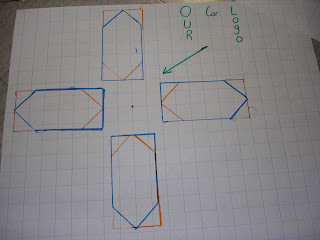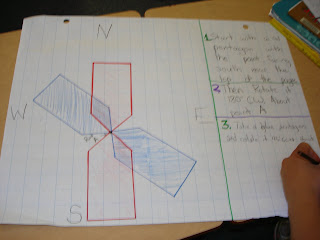Part 1
To activate student prior knowledge, Cynthia began by asking students about lines of symmetry and rotational symmetry. She started with a square. Students identified that the square has 4 lines of symmetry and 4 rotational symmetry. Cynthia then moved on to more complex shapes. She asked students to identify the number of lines of symmetry and the rotational symmetry of this shape:
After students identified the 8 lines of symmetry and rotational symmetry, they had the opportunity to double check against the original by physically turning the shape.
After this, Cynthia modelled how to create a design based on a description of transformations.
Students took turns to follow the directions and create the final product.
Part 2
With prior knowledge activated, Cynthia moved on to the main problem, which she had ready on chart paper.
She helped the class understand the problem by completing the KWC chart with them.
Students got into their groups and began solving the problem using chart paper and markers. Many students started their design right away while some made a plan first.
This group made their design first then tried to find the rotations to fit the design.
There were many different designs that incorporated different rotations.
Part 3
Cynthia choose two groups to share their design and description with the whole group during the math congress. During the congress, the group read their description to another student. This student followed their description and tried to recreate the design. This is the first group that shared:
This is the second group that shared.
Students were able to re-create both designs based on the descriptions. However, Cynthia noticed there was a lot of dialogue between the group describing the logo and drawer (there shouldn't be anything!).
Next Steps
Cynthia is going to wrap up the unit and move on to an independent assessment task.













No comments:
Post a Comment